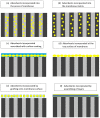Adsorptive Membrane for Boron Removal: Challenges and Future Prospects
- PMID: 36005713
- PMCID: PMC9415005
- DOI: 10.3390/membranes12080798
Adsorptive Membrane for Boron Removal: Challenges and Future Prospects
Abstract
The complexity of removing boron compounds from aqueous systems has received serious attention among researchers and inventors in the water treating industry. This is due to the higher level of boron in the aquatic ecosystem, which is caused by the geochemical background and anthropogenic factors. The gradual increase in the distribution of boron for years can become extremely toxic to humans, terrestrial organisms and aquatic organisms. Numerous methods of removing boron that have been executed so far can be classified under batch adsorption, membrane-based processes and hybrid techniques. Conventional water treatments such as coagulation, sedimentation and filtration do not significantly remove boron, and special methods would have to be installed in order to remove boron from water resources. The blockage of membrane pores by pollutants in the available membrane technologies not only decreases their performance but can make the membranes prone to fouling. Therefore, the surface-modifying flexibility in adsorptive membranes can serve as an advantage to remove boron from water resources efficiently. These membranes are attractive because of the dual advantage of adsorption/filtration mechanisms. Hence, this review is devoted to discussing the capabilities of an adsorptive membrane in removing boron. This study will mainly highlight the issues of commercially available adsorptive membranes and the drawbacks of adsorbents incorporated in single-layered adsorptive membranes. The idea of layering adsorbents to form a highly adsorptive dual-layered membrane for boron removal will be proposed. The future prospects of boron removal in terms of the progress and utilization of adsorptive membranes along with recommendations for improving the techniques will also be discussed further.
Keywords: adsorptive membrane; boron; dual-layered membrane; surface modification; water treatment.
Conflict of interest statement
The funders had no role in the design of the study; in the collection, analyses or interpretation of the data; in the writing of the manuscript; or in the decision to publish the results. The authors declare no conflict of interest.
Figures












Similar articles
-
Novel adsorptive PVC nanofibrous/thiol-functionalized TNT composite UF membranes for effective dynamic removal of heavy metal ions.J Environ Manage. 2021 Apr 15;284:111996. doi: 10.1016/j.jenvman.2021.111996. Epub 2021 Jan 31. J Environ Manage. 2021. PMID: 33535125
-
Advances in Technologies for Boron Removal from Water: A Comprehensive Review.Int J Environ Res Public Health. 2022 Aug 27;19(17):10671. doi: 10.3390/ijerph191710671. Int J Environ Res Public Health. 2022. PMID: 36078388 Free PMC article. Review.
-
Removal of heavy crude oil from water surfaces using a magnetic inorganic-organic hybrid powder and membrane system.J Environ Manage. 2019 Oct 1;247:9-18. doi: 10.1016/j.jenvman.2019.06.050. Epub 2019 Jun 20. J Environ Manage. 2019. PMID: 31229787
-
Adsorptive nanocomposite membranes for heavy metal remediation: Recent progresses and challenges.Chemosphere. 2019 Oct;232:96-112. doi: 10.1016/j.chemosphere.2019.05.174. Epub 2019 May 23. Chemosphere. 2019. PMID: 31152909 Review.
-
Recent Progress of Adsorptive Ultrafiltration Membranes in Water Treatment-A Mini Review.Membranes (Basel). 2022 May 13;12(5):519. doi: 10.3390/membranes12050519. Membranes (Basel). 2022. PMID: 35629845 Free PMC article. Review.
Cited by
-
Effective Removal of Boron from Aqueous Solutions by Inorganic Adsorbents: A Review.Molecules. 2023 Dec 21;29(1):59. doi: 10.3390/molecules29010059. Molecules. 2023. PMID: 38202645 Free PMC article. Review.
-
Graphene oxide functionalized with N-methyl-d-glucamine as a novel sorbent for boron removal from produced and formation waters.RSC Adv. 2024 Feb 9;14(8):5319-5330. doi: 10.1039/d4ra00037d. eCollection 2024 Feb 7. RSC Adv. 2024. PMID: 38344000 Free PMC article.
-
Polymeric Membranes for Liquid Separation: Innovations in Materials, Fabrication, and Industrial Applications.Polymers (Basel). 2024 Nov 22;16(23):3240. doi: 10.3390/polym16233240. Polymers (Basel). 2024. PMID: 39683985 Free PMC article. Review.
-
Novel fabrication techniques for HKUST-1 adsorptive nanocomposite membrane for heavy metals removal from wastewater.Sci Rep. 2025 Apr 26;15(1):14636. doi: 10.1038/s41598-025-99135-0. Sci Rep. 2025. PMID: 40287567 Free PMC article.
-
Preparation and Performance Study of Boron Adsorbent from Plasma-Grafted Polypropylene Melt-Blown Fibers.Polymers (Basel). 2024 May 22;16(11):1460. doi: 10.3390/polym16111460. Polymers (Basel). 2024. PMID: 38891407 Free PMC article.
References
-
- Bond N.R., Burrows R.M., Kennard M.J., Bunn S.E. Chapter 6—Water Scarcity as a Driver of Multiple Stressor Effects. In: Sabater S., Elosegi A., Ludwig R., editors. Multiple Stressors in River Ecosystems. Elsevier; Amsterdam, The Netherlands: 2019. pp. 111–129. - DOI
-
- Bixio D., Thoeye C., De Koning J., Joksimovic D., Savic D., Wintgens T., Melin T. Wastewater reuse in Europe. Desalination. 2006;187:89–101. doi: 10.1016/j.desal.2005.04.070. - DOI
-
- Kharal N. Selection of Novel Technology For Wastewater Treatment. 2017. [(accessed on 20 July 2022)]. Available online: https://www.researchgate.net/publication/318115987_Selection_of_Novel_Te....
-
- Zuo K., Wang K., DuChanois R.M., Fang Q., Deemer E.M., Huang X., Xin R., Said I.A., He Z., Feng Y., et al. Selective membranes in water and wastewater treatment: Role of advanced materials. Mater. Today. 2021;50:516–532. doi: 10.1016/j.mattod.2021.06.013. - DOI
Publication types
Grants and funding
LinkOut - more resources
Full Text Sources

